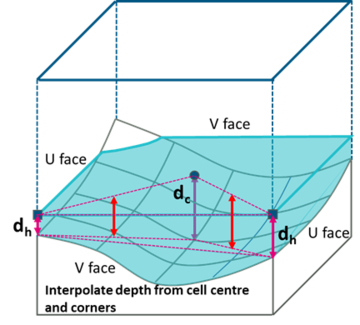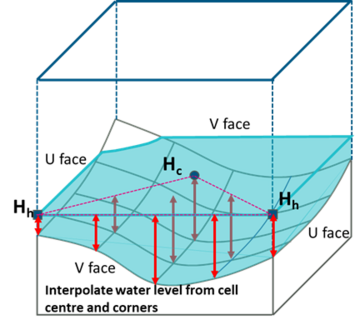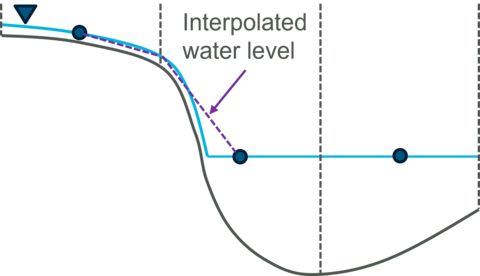TUFLOW HR Output
Page Under Construction
Introduction
High Resolution (HR) Grid/Raster Map Outputs was first introduced in TUFLOW 2020-10-AB release. When an SGS model uses “SGS Approach == Method C”, the sampled elevations are retained at the end of the geometry processing. These sub-grid elevations include topography modifiers such as breaklines, and they allow a high-resolution elevation check file to be written and used for high resolution depth map outputs. Currently, ASC, FLT and TIF raster formats are supported.
For the HR output the water level at each HR output location is interpolated from the computed 2D water levels. The depth is the difference between the interpolated water level and the sub-grid elevation. This differs from the standard depth output which calculates the depths at cell centres and corners first, then interpolate the depths to the standard output grid locations(default is half the cell size). The difference in the interpolation process is illustrated below.
The advantage of the HR output is that it can retain the sub-grid detail of the terrain information even at coarse cell size. As compared in the example below, the HR depth output shows clear flow path even at 100m grid. However, nicer depth output does not mean reliable hydraulic result. In fact, the 100m cell size is too coarse to produce reliable/converged hydraulic results for any real-world flood model. It's is strongly recommended that the model convergence/benchmarking tests must be conducted based on the standard map output, and the HR output should be used for presentation purpose only.
Enable High Resolution Output
To produce high-resolution output, add “HRASC”, “HRFLT” or “HRTIF” to the “Map Output Format ==” command, for example:
Map Output Format == XMDF TIF HRTIF
At the moment, only water level and depth are supported as the High Resolution Output formats, i.e.:
HRTIF Map Output Data Types == h d
The map output data types and output interval can be defined separately for the High Resolution Output formats. For example:
Map Output Interval == 600 ! Sets all map output interval to 600 seconds
HRTIF Map Output Interval == 3600 ! Sets HR map output interval to 3600 seconds
The output resolution for high resolution grid output is defined using the following .tcf command:
HR Grid Output Cell Size == 0.5 ! m or ft
If this command is omitted, the default output resolution is set as the SGS sampling distance.
HR outputs are supported by HPC and Quadtree Output Zones. Below is an example of tcf commands to set up HR output in a output zone:
Model Output Zones == ZoneA
Define Output Zone == ZoneA Read GIS Output Zone == ..\model\gis\2d_oz_S05_002_R.shp Write Check Files INCLUDE == dem_Z ! includes only dem_Z check file for this output zone Map Output Format == HRTIF HRFLT Map Output Data Types == h d HRFLT Map Output Interval == 3600 HR Grid Output Cell Size == 0.5 End Define
If HR output is defined in the Map Output Format, a high-resolution DEM_Z check file (DEM_Z_HR) is produced instead of the DEM_Zmin check file.
Water Level Interpolation Method
Similar to the standard output, the HR output needs to interpolate cell centre water levels to cell corners. However, the interpolation methods for the standard output (Map Output Corner Interpolation == Method C) can produce "bumpy" HR water level output in direct rainfall models with steep terrain, as the water level is linearly interpolated from the cell centres/corners, while the change of sub-grid elevations may not be linear. This often happens between fully wet cells and sheet flow cells, as illustrated below.
In the HR water level output, these locations open have high water level with triangular shape.
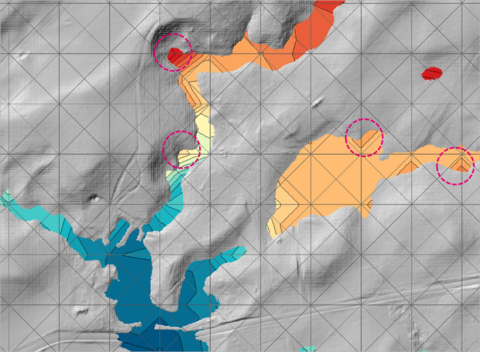
HR Interpolation Approach == Method A
Two additional methods have been added for the HR corner water level interpolation:
HR Interpolation Approach == {Method A} | Method B | Method C
- Method A is the default option that applies the same water level interpolation method used for the standard output.
- Method B performs sheet flow checks at cell faces and ignores the water level from the upstream cell.
- Method C applies the same sheet flow checks as the Method B. In addition, it also uses the number of wet SGS sampled points as a weighting that biases non-sheet flow cells that further improves the mapping to in-stream water levels.
The two images below present the high-resolution water level output at the same location, but with HR Interpolation Approach == Method B and Method C. As can be seen, the water level along the narrow stream is “smoother”.
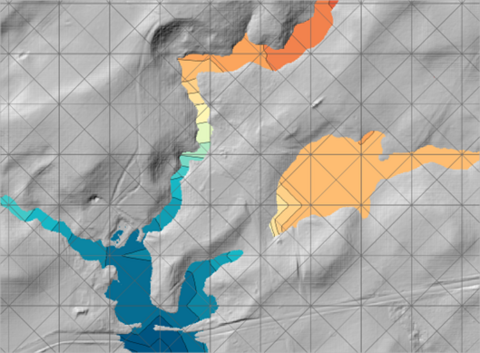
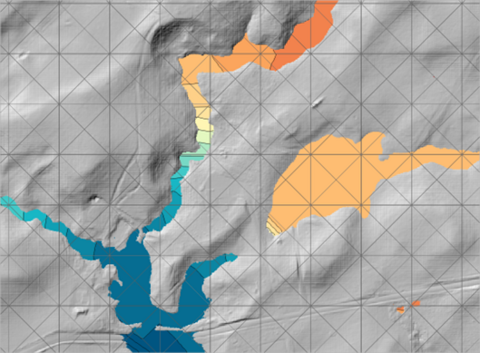
HR Interpolation Approach == Method B (left) and Method C (right)
Note that when these two methods are applied, the interpolated corner water level is biased to the non-sheet flow cells, and consequently, sheet flow cells may appear as “dry” cells. The improved approach that takes into the account of the sheet flow water level is currently under development.
Whilst Methods B and C can substantially improve the water surface mapping of SGS models using direct rainfall (rain-on-grid), there will always be inaccuracies with mapping at a higher resolution than the 2D cell resolution due to interpolation and extrapolation. Regardless of the software, the greater the ratio of 2D cell size to the high-resolution DEM cell size, the greater the potential for mapping inaccuracies. Should better mapping accuracy be required, reducing the 2D cell size to compute the spatial variation in water surface and velocities more accurately is, by far, the best course of action.
Please also note that it is not necessary to use these options for non-rainfall on grid models.
Interpolation near Thin Breakline
- under construction
Any further questions please email TUFLOW support: support@tuflow.com
| Up |
|---|
